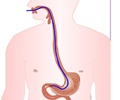How is Whipple’s disease Diagnosed and Treated?
Whipple’s disease is diagnosed using the reverse transcriptase PCR of bacterial 16S ribosomal RNA. It is treated with antibiotics.
Diagnosis:
The presence of oculofacial-skeletal myorhythmia or oculomasticatory myorhythmia, which are characteristic of Whipple’s disease, confirms the diagnosis of this condition.
An
CT or MRI scan of the abdomen may show abnormalities in the intestines and the presence of enlarged lymph nodes.
Blood tests may show the presence of several abnormities due to malabsorption like anemia and low protein levels. The ESR is invariably raised, indicating the presence of inflammation. Fat content in the stools may be abnormal as detected by a stool test.
A stereotactic brain biopsy may be obtained to demonstrate disease of the brain.
X-rays may be used to demonstrate the presence of the disease in the joints.
The reverse transcriptase PCR of bacterial 16S ribosomal RNA from biopsy samples is used in definitive diagnosis of the condition.
Treatment:
Antibiotics are effective in the treatment of Whipple’s disease, to which a dramatic response is often observed. These include trimethoprim-sulphamethoxazole which has to be administered over long duration.
Brain disease should be treated more aggressively with antibiotic injections like ceftriaxone, streptomycin and trimethoprim-sulphamethoxazole, followed by oral trimethoprim-sulphamethoxazole or oral cefixime over prolonged durations.
Interferons have also been tried in the treatment of Whipple’s disease of the brain.






